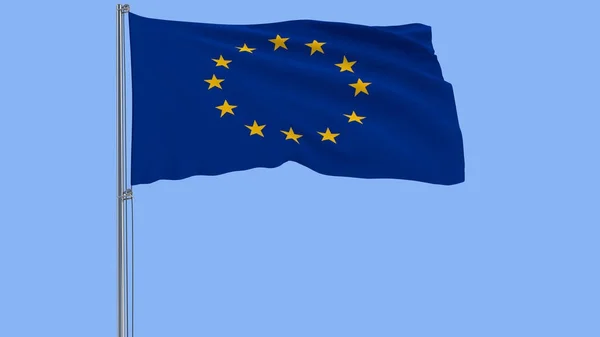Friday, May 31, 2024 5:55 AM EST

Image Source: DepositPhotos
Eurozone headline inflation ticked up from 2.4 to 2.6% in May, and core inflation increased from 2.7 to 2.9%. While the European Central Bank seems set to lower rates next week, the debate over how much the ECB can release the brakes on the economy over the rest of the year will be heated.
Eurozone headline inflation jumped in May, mainly thanks to higher services inflation. The effect was seen in several larger countries, with Germany, Spain and France all experiencing significant increases. While base effects do play a role – think of German public transport ticket prices – this does illustrate that the final throws of getting inflation back to target are not necessarily easy.
With the ECB on the eve of deciding on a historic rate cut, this adds to doubts about the future inflation path. While many forward-looking indicators remain benign, a hot labour market, continued supply chain disturbances, and a recovery of purchasing power will make for an interesting debate at the ECB governing council as they decide on the path of monetary policy from here on in.
Core inflation seems set to decelerate again, but the question is at what pace? Services inflation remains elevated for now but forward-looking indicators do gradually move in the right direction. Still, we expect services inflation to trend around 3.5% towards the end of the year, well above target. If goods demand returns on the back of higher real wage growth, goods inflation could accelerate somewhat again towards the end of the year as supply chain problems still modestly curb supply.
Wage growth is a key element in bringing inflation down, but surprised to the upside in the first quarter. The ECB was correct to dismiss this as resulting from German one-off payments as other countries see faster deceleration. Still, with unemployment remaining at a record low of 6.4%, the decline in wage growth over the rest of the year remains uncertain. For the ECB, the outlook for wages is encouraging enough to cut rates for the first time since 2019 next week. The question remains: how many cuts can follow, and the May inflation serves as a warning that next week might not mark the start of a traditional cutting cycle.
More By This Author:
Rates Spark: Higher PCE Inflation Would Keep The 10yr Target At 5% FX Daily: All To Play For With The Core PCE Deflator The Commodities Feed: Eyes On OPEC+
Disclaimer: This publication has been prepared by the Economic and Financial Analysis Division of ING Bank N.V. (“ING”) solely for information purposes without regard to any ...
more
Disclaimer: This publication has been prepared by the Economic and Financial Analysis Division of ING Bank N.V. (“ING”) solely for information purposes without regard to any particular user's investment objectives, financial situation, or means. ING forms part of ING Group (being for this purpose ING Group NV and its subsidiary and affiliated companies). The information in the publication is not an investment recommendation and it is not investment, legal or tax advice or an offer or solicitation to purchase or sell any financial instrument. Reasonable care has been taken to ensure that this publication is not untrue or misleading when published, but ING does not represent that it is accurate or complete. ING does not accept any liability for any direct, indirect or consequential loss arising from any use of this publication. Unless otherwise stated, any views, forecasts, or estimates are solely those of the author(s), as of the date of the publication and are subject to change without notice.
The distribution of this publication may be restricted by law or regulation in different jurisdictions and persons into whose possession this publication comes should inform themselves about, and observe, such restrictions.
Copyright and database rights protection exists in this report and it may not be reproduced, distributed or published by any person for any purpose without the prior express consent of ING. All rights are reserved. ING Bank N.V. is authorised by the Dutch Central Bank and supervised by the European Central Bank (ECB), the Dutch Central Bank (DNB) and the Dutch Authority for the Financial Markets (AFM). ING Bank N.V. is incorporated in the Netherlands (Trade Register no. 33031431 Amsterdam). In the United Kingdom this information is approved and/or communicated by ING Bank N.V., London Branch. ING Bank N.V., London Branch is deemed authorised by the Prudential Regulation Authority and is subject to regulation by the Financial Conduct Authority and limited regulation by the Prudential Regulation Authority. The nature and extent of consumer protections may differ from those for firms based in the UK. Details of the Temporary Permissions Regime, which allows EEA-based firms to operate in the UK for a limited period while seeking full authorisation, are available on the Financial Conduct Authority’s website.. ING Bank N.V., London branch is registered in England (Registration number BR000341) at 8-10 Moorgate, London EC2 6DA. For US Investors: Any person wishing to discuss this report or effect transactions in any security discussed herein should contact ING Financial Markets LLC, which is a member of the NYSE, FINRA and SIPC and part of ING, and which has accepted responsibility for the distribution of this report in the United States under applicable requirements.
less
How did you like this article? Let us know so we can better customize your reading experience.




